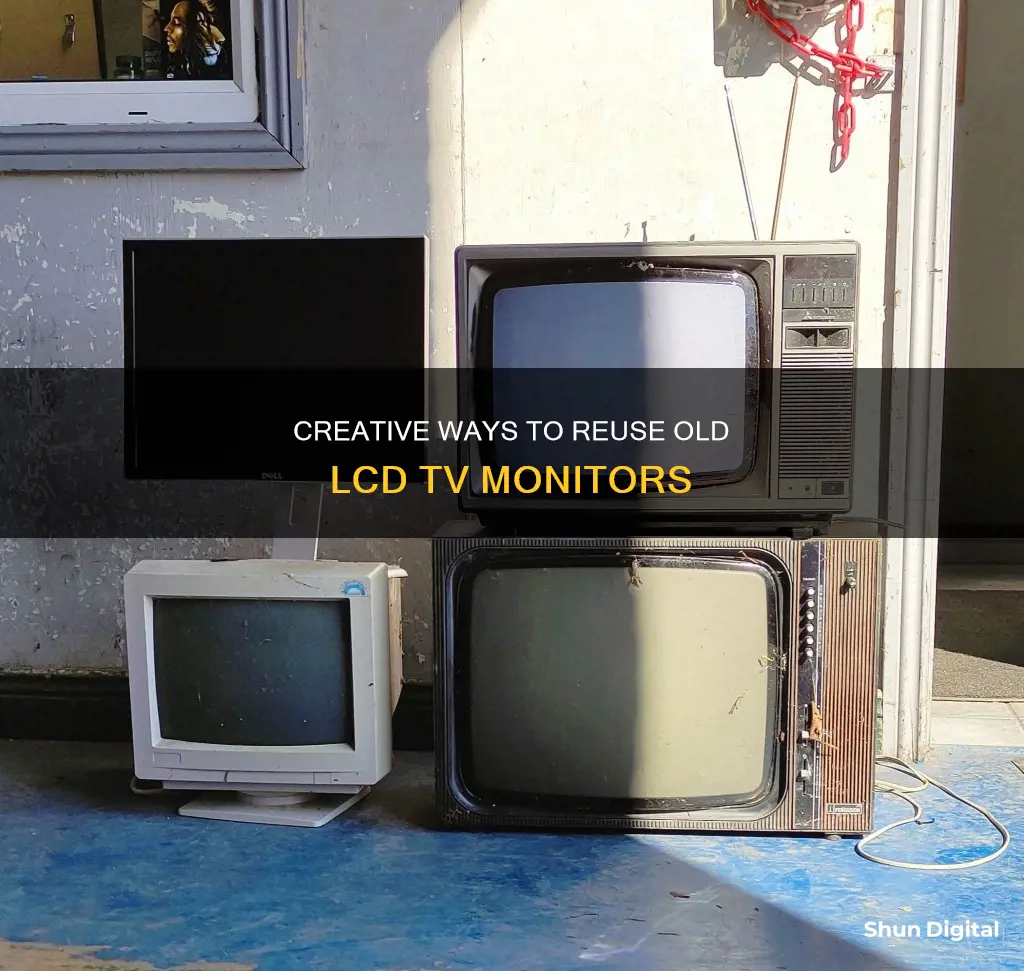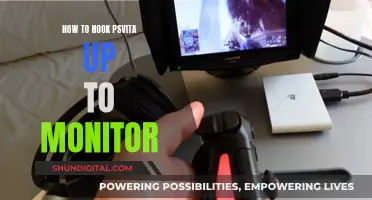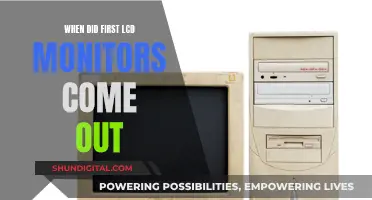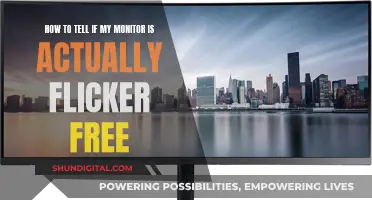
If you have an old LCD TV monitor, there are several options for what to do with it. You could try selling it, either online or to a local shop or repair store, or donate it to a charity. If it's broken, you could recycle it through a specialist company or a local recycling centre. Alternatively, you could repurpose it, for example, by turning it into a smart mirror, a skylight, a fish tank, or a second monitor.
| Characteristics | Values |
|---|---|
| What to do with an old LCD TV monitor | Dispose of it properly, recycle it, sell it, or repurpose it. |
| Repurpose ideas | Secondary display, game emulator or arcade machine, TV, smart mirror, skylight, fish tank, bar, digital photo frame, audio visualizer, clock, light panel, home information center, etc. |
| Recycling options | Local recycling centers, CheckSammy, Best Buy, Goodwill, Salvation Army, Savers, local charities, local schools, etc. |

Sell it
If you have an old LCD TV monitor that you no longer need, one option is to sell it. Here are some tips to help you sell your old LCD monitor quickly, easily, and safely:
- Know your product: Identify the make, model, size, and brand of your LCD monitor. This information will be important when creating your listing and setting a price.
- Set a realistic price: Don't ask for a price higher than the current lowest-priced new monitor of the same size. A good rule of thumb is to set the price at 20% below the cost of a brand-new monitor of the same size and with similar features.
- Take clear photos: Make sure to include a photo of the monitor displaying a picture or video. Buyers want to see that the monitor is in working condition.
- Provide a detailed description: In your listing, mention the condition of the monitor, including any dead pixels, backlight issues, or other relevant details. Be honest and transparent about any flaws or defects.
- Choose the right platform: In the USA, Craigslist is a popular option for selling used items. Other options include Facebook Marketplace, OfferUp, or Letgo, depending on your location.
- Specify local pickup only: In your listing, specify that the sale is for local buyers only and that you will only accept cash payments. Shipping can be complicated and may increase the price beyond what buyers are willing to pay.
- Be concise in your listing: You don't need to include a lengthy description or backstory. Simply provide the essential details about the monitor, such as its size, brand, model, and condition.
- Be prepared to negotiate: Potential buyers may try to haggle, so be prepared to negotiate on the price. You can expect to receive offers below your asking price, so set your price accordingly.
- Avoid discussing price via email: If a potential buyer tries to negotiate the price via email, respond by letting them know that you are willing to discuss the price when they come to see the item in person.
- Be cautious of scammers: Ignore requests for shipping, and be wary of offers that seem too good to be true. Only accept cash payments or secure payment methods to protect yourself from fraudulent transactions.
By following these tips, you can effectively sell your old LCD TV monitor and make some extra money while freeing up space in your home.
Monitoring Docker Container Resource Usage: A Comprehensive Guide
You may want to see also

Donate it
Donating your old LCD TV monitor is a great way to give back to your community while also ensuring your monitor is disposed of responsibly. There are several organisations that will accept your old TV and put it to good use. For example, Pickup Please in the US offers a free donation pickup service where they collect your old electronics and sell them on behalf of the Veterans of Foreign Wars (VFW) organisation, helping to support US veterans and their families. They accept LCD TV monitors in most areas, excluding California and Pittsburgh.
If you're based in California, you can donate your old TV or monitor to California Electronics Recycler in Santa Ana, who will ensure your items don't end up in landfill and save you from any illegal disposal fines.
You can also donate your old LCD TV monitor to a local charity shop, which may then sell it on to raise funds for their charitable work. It's worth calling your local charity shops to check if they're able to accept your donation, and whether they have any specific requirements for drop-off or collection.
Before donating your old LCD TV monitor, it's a good idea to give it a quick clean and make sure it's in good working order. You might also want to check with the donation centre to see if they have any specific requirements or restrictions for the types of electronics they can accept.
Monitoring Bandwidth Usage: Firewall's Role and Importance
You may want to see also

Recycle it
Recycling your old LCD TV monitor is a great way to ensure that it doesn't end up in a landfill, where it could potentially cause harm to the environment. Here are some detailed steps and tips to help you recycle your old LCD TV monitor:
Prepare the Monitor for Recycling:
- Unplug all cables, including power, DVI, HDMI, or VGA cables, to make transportation easier and safer.
- Use a dolly or a rolling chair to move the monitor, especially if it's heavy, to avoid the risk of dropping it.
- Place a towel or blanket in your vehicle and put the monitor face down to protect it during transport.
Find a Recycling Center:
- Look for a specialized electronics recycling center near you. You can use online resources like the Recycling Locator to find drop-off locations for computer monitors.
- Check with retailers like Best Buy and Staples, which offer in-store recycling programs for various electronics, including LCD monitors. Some states even offer reimbursement in the form of gift cards for recycling certain items.
- Contact your local waste management services to inquire about electronics recycling programs or events. Many cities and counties host electronics recycling events, especially around Earth Day on April 22.
- Reach out to your office or local businesses to suggest organizing a recycling drive. E-waste recyclers may offer to pick up electronics at no charge if enough people participate.
Understand the Recycling Process:
- When recycling LCD monitors, it's crucial to keep toxic metals like lead and mercury contained within the device. That's why it's important to leave the recycling process to professionals.
- Almost 98% of an LCD monitor can be recycled. Plastics can be recycled into new products, printed circuit boards can be smelted to recover valuable metals, and cabling can be stripped to reclaim copper and other metals.
Additional Tips:
- If your LCD TV monitor is still functional, consider donating it to charities or local shops. They can resell it to people who might not be able to afford newer models.
- If you have multiple items to recycle, including other electronics, check the limits and guidelines of the recycling center or retailer. For example, Best Buy allows up to three items per household per day for recycling certain products.
- Be mindful of any fees associated with recycling. Some retailers and recycling centers may charge a fee for certain items, while others offer their services for free.
Monitoring Disk Usage: Strategies for Efficient Data Management
You may want to see also

Turn it into a skylight
If you have an old LCD TV monitor with a broken LCD panel, you can upcycle it into a skylight to fake daylight in any room. Here's how you can do it:
Deconstructing the Display
First, carefully disassemble the TV by unscrewing the back panel and removing all the internal electronics and metal components. Remove the metal border and LCD panel until you're left with the backlight panel. The backlight panel is made up of several layers, including a fresnel lens layer, a diffusion layer, and various reflectors. Be cautious when handling the CCFL bulbs or lamps as they are made of glass and contain mercury.
Powering the Display
The next step is to figure out how to power the display. You can either use the original light source (LED strips or CCFL bulbs), but this requires a good understanding of electronics to avoid accidents. A safer option is to replace them with high-CRI LED strips that have adhesive on the back.
Reassembling the Display
Once you've installed the new LED strips and wired them up, you can reassemble the display. Place the diffusion and fresnel layer back, but you may need to leave the second diffusion layer out if it reduces the light output too much. If the original border doesn't fit, you can use tape to keep everything in place or custom-make a new metal border and fasten it with epoxy.
Wiring and Power Socket
Finally, complete the wiring by extending it and adding a power socket to your new skylight.
By following these steps, you can turn your old LCD TV monitor into a bright and smooth light source that convincingly simulates a skylight, bringing daylight into any room.
Eliminating Gridlines: A Guide for ASUS Monitor Users
You may want to see also

Transform it into a fish tank
If you have an old LCD TV monitor and want to transform it into a fish tank, there are several steps you should follow to ensure that your fish have a safe and comfortable home.
First, you'll need to find an old wooden TV console. These consoles usually have a removable back, but if yours doesn't, you can go in through the side. Once you've accessed the inside of the TV, remove all the electrical components, including the tube. Be very careful not to shatter the tube, as older models can be dangerous.
Next, you'll want to measure the inside of the TV to find an aquarium that fits perfectly inside. Cut off the top of the TV and attach hinges to create a lid that can be easily opened and closed. If your TV has control knobs, consider removing them to make more space, especially if they're taking up the area where you plan to put the air pump.
Before placing the aquarium inside the TV, it's important to reinforce the bottom of the console to ensure it can bear the weight of the water. You can do this by replacing it with a stronger piece of wood or reinforcing it with additional wood or metal. It's also crucial to weatherproof all surfaces with a water-resistant finish like polyurethane to protect the wood from moisture damage.
Drill holes in the back panel of the console for cords and tubes, and consider adding an extra hole to encourage ventilation and reduce condensation. If you need to run a cord from the tank to a power source, you can attach a surge protector to the outside of the back of the cabinet to bridge the distance neatly.
Now, it's time to assemble the tank. Attach the pump, filter, and hoses, and set up the aquarium. Before adding fish, it's essential to cycle the tank to create a healthy environment for them to live in. This process is called fishless cycling, and it's crucial for the well-being of your future fishy friends.
Finally, decorate the tank with gravel, plants, and any other accessories your fish might enjoy. You can even add LED lighting strips to the exterior of the TV to give it a modern touch.
Monitoring Wi-Fi Usage on iPhone: A Step-by-Step Guide
You may want to see also
Frequently asked questions
It is not recommended to throw away old LCD TV monitors as they contain toxins that can harm the environment. Instead, consider recycling the monitor through an electronic waste (e-waste) program or donating it to a local charity or nonprofit organization.
Yes, there are several ways to repurpose an old LCD TV monitor. You can use it as a secondary display, convert it into a digital picture frame, create a DIY standing desk, or turn it into a smart mirror.
You can get creative with an old LCD TV monitor by converting it into a gaming console, using it for home security monitoring, or turning it into a digital whiteboard. You can also explore options like reselling the monitor or reusing specific internal parts.







